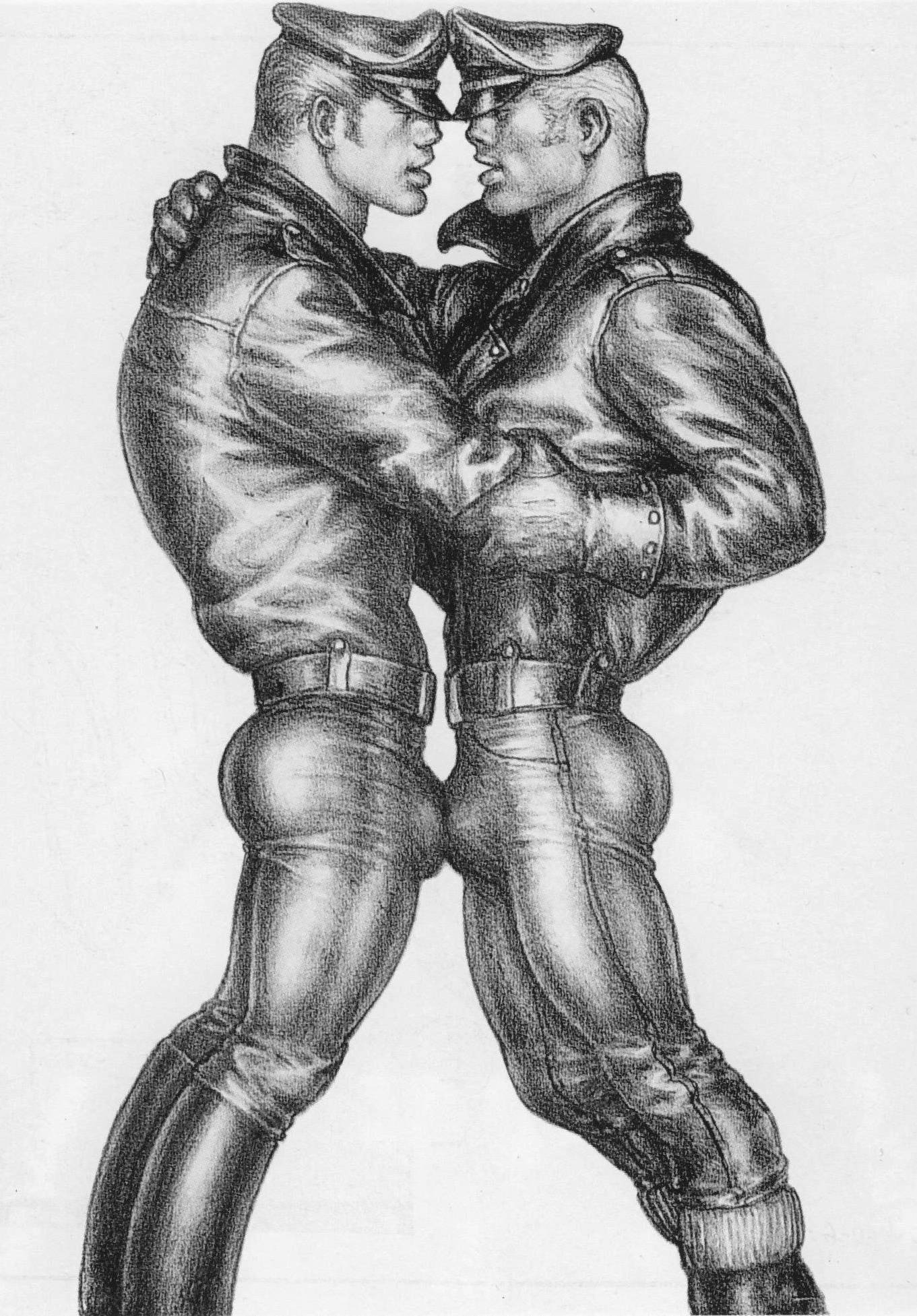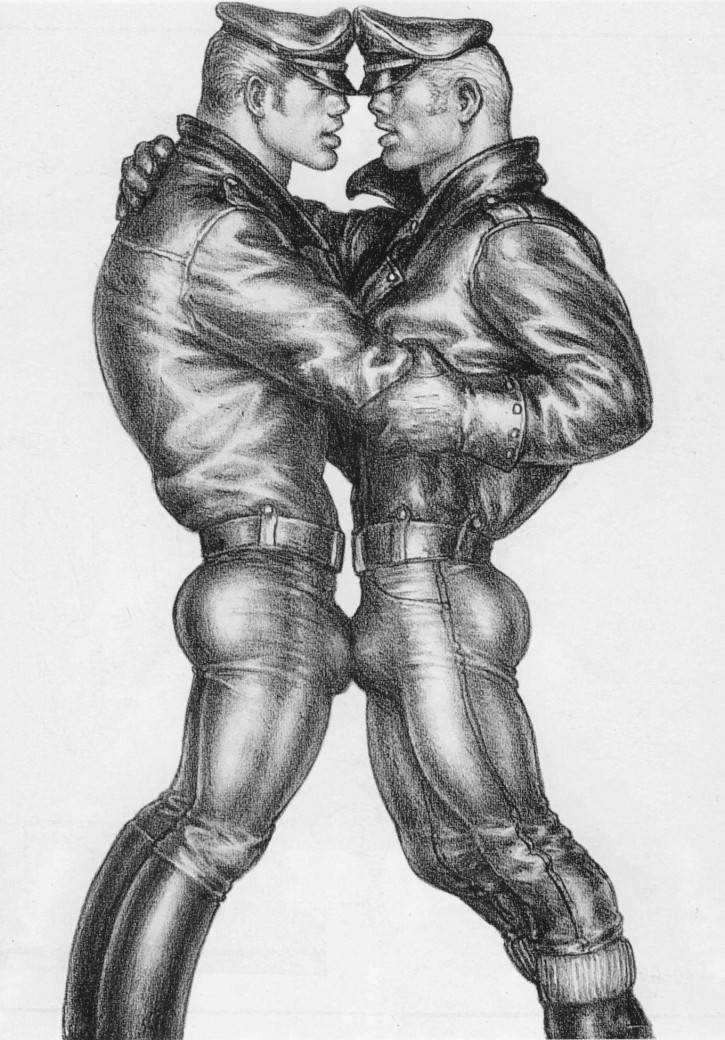Famed erotic artist Tom of Finland made as much of an impact on the lives of individual men as he did on the history of masculine representation. On a palm tree-lined street in Echo Park sits the Tom of Finland Foundation, a site that testifies to both personal and historical memory. Foundation co-founder and former Bruce Weber model Durk Dehner met Tom because of a compelling image on a bathroom wall, and soon became the artist’s muse, patron, and longtime friend. In this short video, Dehner and foundation vice president S.R. Sharp discuss Tom’s radical imaginary, his command of the gay male gaze, how Tom of Finland got his name, and why Tom made the move to Los Angeles. Dehner has preserved the home he shared with Tom as a homage to Tom’s legacy, and to this day, the home remains open to the public.
To schedule a tour of the Tom of Finland Foundation please call 213-250-1685.
http://www.TomOfFinlandFoundation.org
Bob Mizer & Tom of Finland. Organized by MOCA Curator Bennett Simpson and Guest Co-Curator Richard Hawkins. MOCA Pacific Design Center, 8687 Melrose Avenue, West Hollywood, CA 90069. November 2 – January 26, 2014.
Directed by Emma Reeves
Shot by Tom Salvaggio & Andy Featherston
Edited by Tom Salvaggio.
Tom of Finland, 1978. (c) The Robert Mapplethorpe Foundation. Used by permission.





stellar gay iconography…..this stuff pushed me out of the closet and forced me to explore boundaries I didn’t know I had. this art spoke to me in an intimate way that other media of the time didn’t. it gave me an acceptance of my own self-image in a face to face encounter. thanks tom of finland for hanging out with us.
I love all the men of Tom of Finland.
Love Tom of Findland. I love that he used black and white men in a lot of his illustrations and especially in sexual situations. That was very courageous of him at that time to show black men having sex with white men in leather at a time when the leather movement was still a very “Caucasian” man’s secret pleasure.
This is an exhibit you shouldn’t miss. This is the first time these two icons have had a joint show that explains their collaboration. Durk, Sharp and the rest of the crew at ToFF have been working hard for over a year to coordinate this show. The prelims I saw were great. Since this runs through Jan., those visiting for Xmas can take it in. If you do go to MOCA, pop over to the Foundation house, it’s only about 10-15 min. north between Echo Park Lake and Dodger Stadium. This is still Durk’s private residence, so you MUST make an appointment. A donation would be nice too.
I first met Bob Mizer when I was 17 over at Muscle Beach and we were good friends till he died in ’92. Through him I met a never ending batch of wild and wonderful people I would have never crossed paths with otherwise. From street hustlers, future porn stars, Jim French (Colt Studio founder), various celebs and Touku/ToF in the ’80s. Be was an slightly reserved, affable man with a devilish twinkle in his eye. He was a good storyteller when he relaxed and soon you felt you were best friends. Quite a man.
One aspect of Bob naming Touku, Tom, is seldom recounted. It hard to imagine now how dangerous it was to be gay back in these days. Bob only used first or pseudonyms for his featured artists or models to hide their true identity. Bob had already had several runins with the law by the time Tom came around. Bob founded AMG I in 1945. In ’47, he was arrested and convicted for violating the Comstock Laws by mailing several B/W photos of guys in posing straps( g-string). He was sentenced to 9 months labor at Ward man Honor Rancho in Saugus. This is now the Pitchess Honor Ranch..still a working ranch/farm that supplies the jails. In 1954, he became the target of an early tabloid TV show, the “Confidential File”(’53-’58) on a local channel, 5 KTTV. The host was a LA Times Mirror reporter, Paul Coates, who chose lurid topics, scandals and hysteria for ratings. He had already covered gays before. His interview with the Mattachine Society, founded here in LA by Hays, was the first TV interview with a gay activist. Coates would often work with the LAPD to whip up public outrage which they could then act on. Gays were a ripe subject. One night in 1954, Coates picked on the Physique Pictorial as an example of the kind of lurid magazines that “the demi-world of the homosexual, sadist and masochist” would excite to unspeakable acts. The he would add that they would draw no line on preying on young and innocent men. The following morning, May 19 ’54, Bob was arrested. His magazines were no more revealing than the current copies of the new Playboy, but these were natural. At the trial, there was one witness, the arresting officer and 9 photos, some of which should full frontal nudity. Bob would not shoot such pictures till after his mother’s death in ’64 in deference to her as they all lived in her house/studio. Given the times, Bob knew anyway such photos would be instant jail time. The LAPD produced these pictures as evidence. Not only were none of them in Bob’s magazines, Bob didn’t shoot them or own them either, so they were only used to inflame the jury…he was found guilty, jailed and fined again. The verdict was overturned on appeal in ’55. At that point, Bob admitted that it had the desired effect and from then on he was more timid about his work till the mid ’60s. In ’57, the Supreme Court ruled in Roth v. U.S. that obcenity, in any form, was not protected speech under the First Amendment. That same year, Touku sent Bob his first drawings and Bob would use the lumberjack one for his Spring ’54 cover. In this atmosphere of witch hunts, you used first/pseudonyms to have plausible deniability in court. Since he already had seen real Toms submitting art/photos, adding Finland was the logical choice. Not as light a story as usual told, but one that reflected the dark reality of those days.
Bob not only introduced Tom, but Quaintance, Harry Bush, Etienne and other artists to a much wider audience than their work in small pulp magazines reached. They were both unique pioneers.
Durk Dehner often gets lost in Tom’s shadow, but he is notable in his own right. He was runner up in the first IML (lost a coin toss for first!), was a favorite model for Tom and was often featured in Drummer. He has written several histories as well.
Contact MOCA for info/tickets. Look at the publisher Taschen’s website for beautiful books on both artists. Great gifts for yourself or others.
Bad typos above. Was texting while waiting for a flight and didn’t turn off the anticipatory text feature on my phone. It changes my words sometimes. EG: ‘several’ Toms became ‘seems real’ Toms. Had to submit ‘as is’ to board my plane without proofing.
@Fitnessmodel: Remember Tom was working back home and in Europe. Blacks were often viewed in a different light and more socially acceptable across a wider spectrum of circumstances. There wasn’t the same racial history there. Think how Josephine Baker was accepted into Paris society then versus her treatment here. That’s why she stayed. After WWII, most of the motorcycle clubs, that would spawn the leatherman scene, were formed by returning vets in port cities. They were often from poorer backgrounds, education and skill sets which included the racial prejudices of that group. Think of how Unions of that time excluded people of color. Even though the military was progressive for blacks in terms of rank, it was still segregated until Eisenhower gave an executive order to change in the late fifties. Lots of those early clubs were filled with ‘good ol’ boys’. Some clubs were accepting as the brotherhood of service did breakdown old ideas. Check out the Leather Archives & Museum in Chicago. They have a “archivist request” section on their site and much of their photo archive is online now. Chuck Renslow started the first leather bar, the Gold Coast, there and their local contest became IML. He also founded and is pres. of the museum. He still runs IML as well. Check out ONYX, the oldest leather club for people of color. The NY Panthers too. They may have some interesting archives and history. Mapplethorpe had a thing for leather and black men. Also, Jim Wigler covered the SF leather scene for years and has photos. All would welcome your requests.
His art is still iconic after all these yours. A milestone in gay erotica. Wish I could visit the exhibition.
Who doesn’t LOVE classic Tom??!! OINK!!!